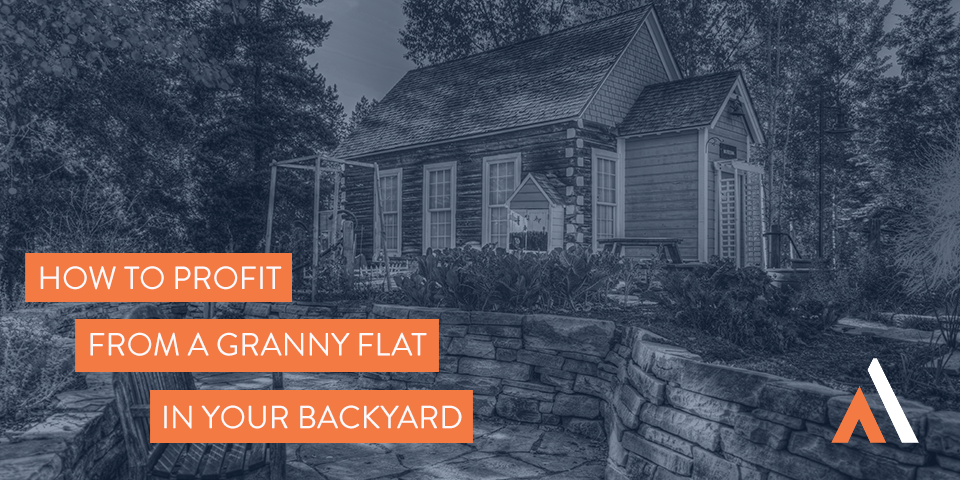
How to profit from a granny flat in your backyard
February 28, 2019 - Blog
There are some definitively Australian structures out there – the Sydney Opera House, the Story Bridge, Federation Square and Parliament House to name a few.
Yes, our wide brown land contains quite a cache of ‘fair dinkum’ builds, but there is one Aussie-built legend that also helps property owners boost rental income – the humble granny flat.
A granny by any other name
The granny flat goes by many labels – Fonzie flat, secondary dwelling, auxiliary home… but all refer to a self-contained second dwelling unit on a single residential allotment.
Granny flats were traditionally built to provide accommodation for older family members.
When a retiree needed some assistance from their family, but didn’t want to lose their independence entirely, a granny flat was the solution.
For homeowners, the flats were also a chance to give young adult children a sense of freedom without them having to wander too far from the nest and all its perks.
But for investors, secondary dwellings have evolved to become an income booster, with many landlords taking the chance to increase their returns.
Their rise in popularity as an investment strategy is easy to understand.
There’s increasing demand for accommodation in major population centres, but land has become progressively less available.
Granny flats have been among the town planning solutions offered by councils trying to address rising densities while avoiding new-unit over-construction.
And granny flats are generally viewed as a ‘win-win’.
Tenants have access to well-presented accommodation at a reasonable price in a desirable location, while owners boost their returns through the extra lease arrangement.
Not all local authorities have jumped on the bandwagon of course – and there are building guidelines that must be complied with – but the option has certainly gained popularity in recent years.
So, if you decide the granny flat path is for you, what’s the financial upside?
Well, the income boost is a potential cracker.
I’ve seen stunning, modern granny flats built for $150,000 that achieve rental returns of $600 per week – that translates to a gross yield of 21 per cent on costs!
Not bad – particularly if it helps with servicing loan repayments so you can hold a property long-term and enjoy the capital gain upside.
Grannies help find a balance between high-growth, low-return houses and high-return, low-growth units.
The challenges
Granny flat construction works well on the cash flow side of the equation but isn’t a smart strategy for capital gains in the short-term.
The added value of the granny flat to a property rarely exceeds the cost of its build.
In my experience, a granny flat costing $150,000 to build might only add $75,000 in value.
It’s an equation that doesn’t add up if you’re hoping to sell soon after construction.
In addition, adding a granny flat to an existing property does impact its utility due to factors such as lost yard space and increased property density.
You may need to reduce the rent on the existing dwelling to compensate for the granny flat’s impact on things like privacy, open space, and parking.
That said, the numbers often stack up for the right investor.
Here’s an example of one I’ve seen recently:
Pre-granny flat
- House purchase price: $1.5 million
- Typical rent: $900 per week
- Yield without granny flat: 3.1%
Post-granny flat
- House purchase plus granny flat: $1.65 million
- Rent house: $800 per week
- Rent granny flat: $600 per week
- Total rent: $1400 per week
- Yield with granny flat: 4.4%
When it comes time to sell your property, however, there is a more restricted buyer pool.
Expect to see mostly investors, or larger families with adult children or elderly relatives among your purchasers.
Maxing the outcome
I have a couple of tips for getting the best result out of a granny flat venture.
First up – think about renter demand in the area.
Granny flats appeal to a small section of the rental market such as single people in public sector jobs, single parents, students or single downsizers.
Students will need a designated quiet space for privacy while commuters may require covered car accommodation.
Make sure you design a flat to meet tenant requirement in your area of interest.
Also, ensure you can comply with council construction guidelines on elements such as floor space restrictions and boundary setbacks while still building a functional and liveable space.
Make sure you’re also within reasonable proximity of lifestyle factors, public transport and employment nodes as well.
These fundamentals guarantee strong tenant demand and maximum rent.
Finally, use an experienced property professional to help you locate a prospective site and run a comprehensive cost-benefit analysis of the project.
Choosing the wrong type of property in the wrong location for a granny flat can be a disaster.
Granny flats can be a profitable option for savvy investors, just make sure the venture fits your long-term strategy.


